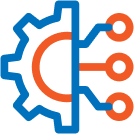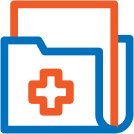
Country Experience Documentation on Digital Health Convergence Workshops
Digital Health Convergence Workshop in Lao PDR 2021
Revitalizing the Digital Health Roadmap: From Multi-stakeholder Planning to Endorsement of the Lao PDR National Digital Health Strategy
Background of Digital Health in the Country
2013
Adoption of DHIS2

2014
Pilot of Supply (Currently the national health logistics management system)

2018-2020
Multiple integration efforts in DHIS2

2021
First digital health convergence workshop in Lao PDR (Hybrid)

Note: Report included in this section is only valid until the time the digital health convergence workshop was conducted in March 2021.
Workshop Implementation
Objectives

Creation of an overseeing governance structure

Plan the development of standards and registries

Find an agreement for the adoption of a unique Patient ID

Improve the cooperation with other ministries

Involve the Ministry of Technology and Communications
Methodology
1
Request
Requested technical advice from AeHIN to conduct the digital health convergence workshop
2
Coordination
Formation of core team:
- Ministry of Health (MoH)
- World Health Organization (WHO)
- Asian Development Bank (ADB)
- Asia eHealth Information Network (AeHIN)
3
Planning and Preparation
- Pre-convergence workshop
- Program planning
- Invitation to stakeholders
- Event logistics
4
Implementation
Discussion points: Digital Health Vision in the Country, AeHIN’s Mind the GAPS Framework, Special Topics on Digital Solutions for Health, Experience-sharing from Neighboring Countries, Translation of Work Group Conclusions into Action Plans
5
Follow-up
- Stakeholder Engagement Workshop (December 2021)
- Digital Health Strategy 2023-2027 Dissemination Workshop (January 2023)
Output
- Identify the digital health champion.
- Identify the department to lead the creation of the digital health governance structure.
- Create a digital health steering committee composed of the MoH and other ministries.
- Create a digital health technical working group composed of the MoH and other ministries.
- Create experts groups working on specific digital health subjects.
- Create a program management office to support the Committees.
- Set the digital health steering committee to convene once every quarter.
- Identify the enterprise architect.
- Identify the department to lead the definition of the digital health enterprise architecture.
- Identify the program management leader.
- Create a program management office to lead digital health project management.
- Identify the future project managers to lead health system developments.
- Identify the standard leader.
- Identify the departments to be the custodian of Health ID and lead its development and implementation.
- Identify the departments to be the custodian of client
registry in the exchanged architecture and lead its
development and implementation. - Identify the department to be the custodian of EMR
standard and lead its development and implementation. - Identify the department to be the custodian of the shared
health record registry in the exchanged architecture. - Identify the responsible department to promote the usage
of eGovernment tools and lead the development of new
eGovernment applications and infrastructures for health. - Identify the responsible department to promote usage of
ICT and improve ICT capacities within the MoH.
- Define the digital health enterprise architecture that responds to all stakeholders for all activities. Adopt an exchanged architecture such as Open Health Information Exchange (OpenHIE) as information systems architecture.
- Define each component of the exchanged architecture and assign ownership.
- Document the current enterprise architecture (baseline), the desired enterprise architecture (target).
- Plan the migration from the baseline to the target enterprise architecture.
- Integrate the digital health enterprise architecture with the enterprise architecture of the eGovernment center of the Ministry of Posts and Telecommunications (MTC).
- Document a program management handbook to be shared to all project managers.
- Create a standard and interoperability lab to develop health standards and experiment interoperability.
- Identify the list of standards to develop and identify the owners.
- Develop in priority national health ID, morbidity and mortality list, and medical terminologies standards.
- Document a standard and guidelines handbook.
- Construct the Health ID standard datasets and formats.
- Develop the interoperability between the health client registry and other health information systems.
- Link the health client registry with the eGovernment Lao KYC database.
- Define EMR standard minimum functions, minimum datasets, data formats, and link with other health standards and coding.
- Document an EMR standard and guideline handbook.
- Promote and support the usage of the standard EMR in health facilities hospital information systems.
- Develop the interoperability of hospital information systems with shared registries and services within the exchanged architecture.
- Integrate the digital health enterprise architecture with the eGovernment enterprise architecture.
- Develop a digital health strategy plan for the next five years.
- Identify the development partners supporting the
implementation of the digital health governance structure. - Identify the development partners supporting the
construction of enterprise architecture foundations. - Identify the development partners supporting the projects led by the program management office.
- Identify health projects to be supported in priority by the program management office.
- Identify the development partners to support the
improvement of project management capacities in the
health sector. - Identify the development partners supporting the development of health standards.
- Identify the development partners to support the creation
of the Health ID standard and create the client registry. - Identify the development partners to support the
development of EMR standards and its implementation in
the hospital information systems. - Create a partnership between MoH and MTC to cooperate
for the development and promotion of eGovernment for
health. - Identify the development partners to support the
improvement of eGovernment infrastructures,
applications, and services within the health sector. - Identify the development partners to support the
improvement of ICT capacities in the health sector. - Document the current level of ICT capacity within the
health sector and define objectives and strategies f
improvement.
- Develop shared registries, shared services, and
interoperability layer inside the exchanged architecture. - Identify which system is the most suitable to manage ID
services: biometrics, registration, authentication, ID
management, etc. - Construct the health client registry based on the family folder exercise.
- Improve new family folder exercise data quality and consistency.
- Streamline birth and death notifications of health facility with the health client registry.
- Assessment of conditions to implement EMR systems within health facilities.
- Identify or develop a pilot system implementing EMR standards.
- Development of Government-to-Government (G2G) applications and services: e-Office, corporate email online storage, document management systems, intranet, etc.
- Development of Government-to-Business (G2B) applications and services: licensing systems for private facilities, information platform, etc.
- Development of Government-to-Citizen (G2C) applications and services: Information platform, vaccination passport, death and birth notification/certification, etc.
- Development of ICT infrastructures in all health facilities throughout the country.
- Development of ICT infrastructures within the administration of the Ministry of Health throughout the country.
- Development of ICT infrastructure and applications for the digital health exchanged architecture: interoperability layer, shared services, shared registry, data centers, and technologies.
- Document the current digital health legal framework, existing strategies, and existing committees.
- Training and certification on governance frameworks such as Control Objectives for Information and Related Technologies (COBIT) 2019.
- Training and certification on enterprise architecture frameworks such as The Open Group Architecture Framework (TOGAF), OpenHIE, and others.
- Increase enterprise architecture capacities through training of trainer format.
- Training and certifications on project management such as Projects in Controlled Environments (PRINCE2) and others.
- Increase project management capacities inside the MoH through the training of trainer format.
- Training and certifications on health standards such as Health Level Seven International Fast Healthcare Interoperaility Resources (HL7 FHIR) and others.
- Train health workers on the usage of eGovernment applications through the training of trainers format.
- Create incentives for inclusion of ICT in medical career pathways for health workers and the administration (ex: monitoring and evaluation, data analyst, health informatics, etc.)
- Create or develop partnerships with medical universities in country or abroad to include ICT in the medical curriculum.
- Increase health workers ICT capacities through training of trainer format.
Key Insights
Emerging Good Practices
Systems review and stakeholder mapping for each identified need
- Review of existing digital health systems, identification of support needed, and mapping of funding agencies and stakeholders
Development, endorsement, and dissemination of a Digital Health Strategy
- Most impactful progress from the convergence workshop
- Tackles overview of the strategy, strategic objectives and projects, and strategy implementation
Establishment of the Health Statistics and Information Center
- Established to unify the roles of previous divisions, concentrate resources, and strengthen available capacity to better manage and implement the digital health strategy
- Tasked with digital health-rated work
Formation of priority-based Digital Health Technical Working Groups
- Digital Technical Working Groups (TWGs) formed based on identified priority activities:
- University Hospital Information System (UHIS)
- Electronic Immunization Record (EIR)
- Laboratory Information Management System (LIMS)
- Electronic Medical Record (EMR)
Membership to the National Digital Governance Transformation Committee
- The Minister of Health is a member of the newly formed National Digital Governance Transformation Committee
- In charge of the implementation of the National Digital Governance Framework
Multi-stakeholder approach in information sharing
- Signed Memorandum of Understanding (MOU) with the Ministry of Home Affairs (MoHA) to exchange birth and death information
Agreement towards exchanged architecture
- The MoH moved from an integrated to an exchanged architecture in alignment with the launched digital health strategy
Building the digital health capacity of prospect digital health program managers
- Some core program management staff undergoing master’s and doctoral-level studies in medical informatics and data science to better support the current digital health governance structure
Standards development and implementation
- Health ID, ICD10, EMR minimum data elements
- Building capacity towards formation of a standards and interoperability lab through AeHIN COIL
Development of services and applications
- Interoperability between client health registry and eCRVS (being developed)
- Interoperability between GeoPrism and DHIS2
- Piloting EMR and DHI2 interoperable projects
Emerging Needs
Support towards the transition of digital health function at the MOH
- Transition from the Department of Planning and Finance to the new Health Statistics and Information Center
Alignment with the National Digital Government Framework
- Establish a roadmap for digital health transformation through its digital health steering committee
- Hold regular meetings among digital health technical working groups to ensure harmonization of efforts and avoid duplication of work
Resources for implementation of data-related policies
- Recruit a workforce for the digital health program management office at the Department of Planning and Finance and provide continuous training
Landscape analysis of the digital health situation
- Landscape analysis on government enterprise architecture, infrastructure, data governance, policy and regulation, healthcare systems, standard and terminology, human resources
- Needs workforce, capacity, and budget support
Awareness-building on digital health
- Familiarize MoH employees with digital health concept, especially with the ongoing implementation of the digital health strategy
Implementation guidance for the rollout of standards and terminology
- Develop implementation guidance for rollout of standards and terminologies, including guidance for customization or localization of global standards (e.g., SNOMED CT, LOINC) in the country


Get Involved
We request representatives from a country's government agency and development partners to answer the form below for any digital health convergence workshop-related inquiries and requests.